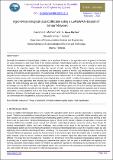| dc.description.abstract | Generally, the variation of meteorological conditions has a significant influence on the agriculture sector in general. In Tanzania, the study conducted in 2015 found most of the existing automatic meteorological stations are not working, and the surveyed manual meteorological stations record meteorological data in the cards daily, but cards are sent in a month to month time interval to the respective organs, this makesthe concept of early warning difficult. Therefore having near-real-time meteorological data will enable the crop monitoring and forecasting systems to monitor crop development and provide early warning to the farmers and the government. The advancement of the Internet of Things (IoT) offers possibilities for developing an integrated sensors network to collect meteorological data on a near-real-time basis. In this study, the developed integrated sensor network includes sensors, which record remote meteorological data such as rainfall, humidity and temperature, a communicationnetwork, and a web application thatenhance data visualization in both graphical and tabular format. In the communication system, the LoRa technology was used, which is more preferable compared to other Low Power Wide Area Network (LPWAN) technologies such as NB-IoT and Sigfox for this application. The developed system uses the LoRa Gateway Operating system which provides capabilities to build a private network, and make it more cost-efficient by reducing the operation cost for account subscription, in online platforms such as The Things Network (TTN), ThingPark, ThingSpeak, and Loriot to avoid free accounts limitations. Moreover, the developed system can work in remote areas with limited Internet access as the meteorological stations can communicate with the gateway at a distance of up to 25km. | en_US |

